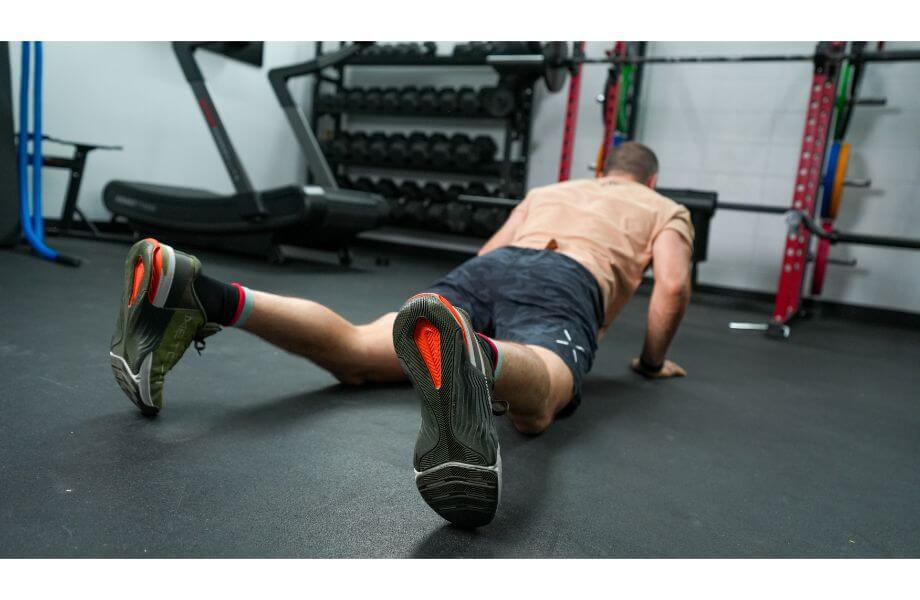We test and review fitness products based on an independent, multi-point methodology. If you use our links to purchase something, we may earn a commission. Read our disclosures.
What happens when your muscles are so tender that squatting down to the toilet is a chore? Can you workout when sore or is the pain a cue to take a rest day?
Here’s the thing: If you continuously stimulate your muscles from strength training (like bodybuilding splits or the big three lifts), it’s pretty common for your workout routine to deliver some amount of soreness.
Muscle soreness is definitely part of the muscle-building process, but it can be hard to know when it’s time to take a rest from physical activity and when to proceed as usual. That’s why I’m going to dive into the ins and outs of working out when sore and why exactly we get sore in the first place.
Why Do Muscles Get Sore?
Resistance training creates adaptations in our body, with the most obvious being changes in our muscle tissue and muscle size. These muscle changes are especially detectable when you intentionally slow down through the eccentric (lowering portion) of a given exercise.
Eccentric training creates micro tears in your muscle fibers, which temporarily damages the muscle and allows it to grow. These micro tears often feel like short-term muscle pain, however this process is associated with long-term muscle growth, aka hypertrophy.
Although muscle damage sounds pretty intense, if you train regularly, you know this is part of the deal on the journey to getting bigger and stronger. However, according to a 2012 study published by the Journal of Strength and Conditioning Research1, muscle soreness is often the most noticeable when you introduce new movements, train a muscle group that is not accustomed to strain, or return to exercise after a period of not training.
Muscle soreness is not limited to the actual muscular strain you feel during a given exercise. Oftentimes soreness affects you one or two days after an intense workout (and lasting up to five days). In a 2005 study published in the Journal of Physiology2, researchers explored delayed onset muscle soreness (DOMS), which typically occurs after training eccentric movements or adding new exercises to your routine.
It’s worth mentioning that DOMS is often uncomfortable and can be painful, but it’s distinctly different from chronic muscle pain or acute pain from injury. That said, we always recommend speaking with your doctor before starting a new fitness routine.
DOMS—delayed onset muscle soreness—is exactly as it sounds: It’s not an immediate soreness while you’re working out or even directly after—it’s usually the following day or two days later. On the opposite side of the spectrum, an injury (in most cases) will feel like sudden and acute pain from movement.
Sometimes excessive soreness that lasts for days can get confused with an injury. Many of us are guilty of overdoing it in the gym by overworking a certain muscle group, lifting too heavy, skipping warm-ups, or even skipping rest days. These things can lead to extreme soreness but can usually resolve themselves with some recovery methods I’ll list below in addition to scheduling rest days.
Working Out When Sore: When Should I Take A Rest?
As a certified personal trainer, let me help clue you in on when it’s time for a rest day:
Consider taking a rest day if:
- Your muscles are swollen and tender to the touch
- It’s difficult to do normal things like get out of bed or tie your shoes
- Light movement doesn’t loosen you up
You can probably train if:
- You’re feeling generally stiff
- Foam rolling helps relieve stiffness and soreness
- Low-impact cardio helps you increase blood flow to sore areas
If you’re too sore and you attempt to train the same muscles, you could subject yourself to an overuse injury at worst, and at best, you won’t perform at your peak.
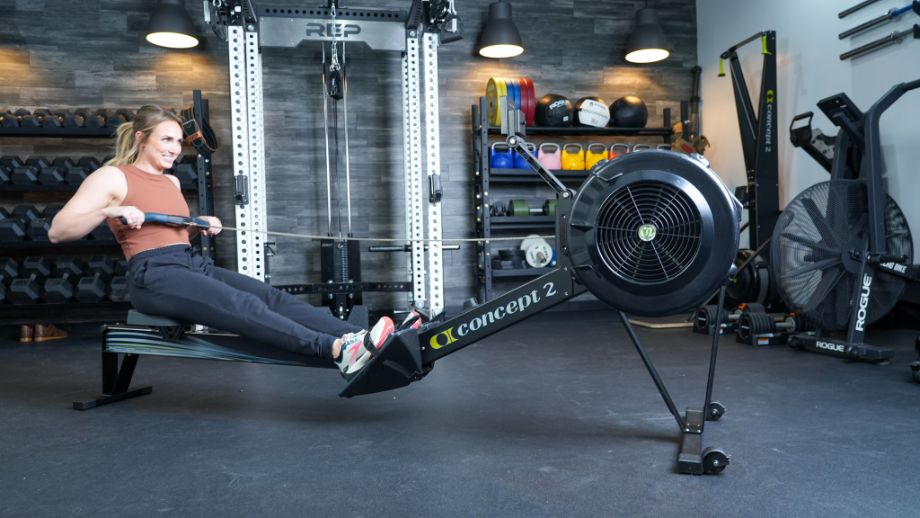
How to Reduce Soreness
Partaking in some active recovery methods can help reduce your soreness and allow you to feel ready for your next workout. Active recovery will help increase blood flow to sore areas, which will help reduce pain and inflammation.
Active recovery is a general term used for athletes and gym goers alike to describe activity and movement of non-training days. Examples of active recovery might include walking, swimming, yoga, stretching, massage, compression, and cryotherapy.
In a 2018 study published in Frontiers in Physiology3, researchers reviewed several different types of active recovery to determine which one was the most effective—and you know what they found? Massage was the most effective method to decrease inflammation and fatigue related to DOMS.
Let’s take a dive into how to incorporate massage to your routine, plus other methods that can help reduce soreness:
Self Massage
Although massage is an effective recovery method, it’s probably not feasible (neither for your time or bank account) for us working folks to schedule an appointment with a licensed massage therapist after every workout.
That said, there are two self-massage methods I particularly like: foam rollers and massage guns. I’m not the only one who thinks highly of the mighty foam roller—a 2015 study from the Journal of Athletic Training4 found that foam rolling as part of your cool down can help heal muscle damage by increasing blood flow to sore muscle tissue.
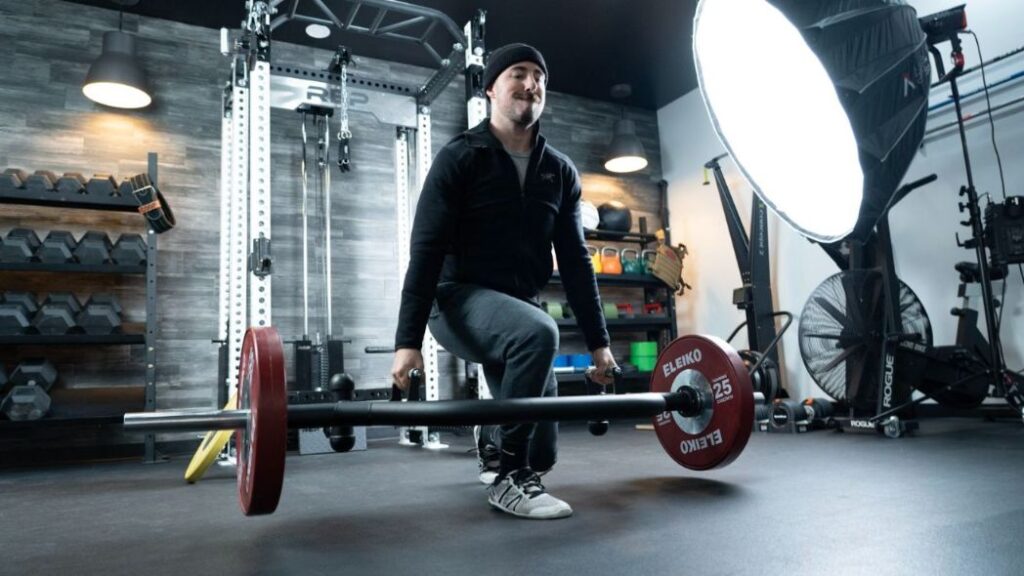
That said, I understand that getting on a foam roller after a workout full of squats and lunges might be the last thing you want to do. In that case, a massage gun can be an effective tool that doesn’t require your full bodyweight on the floor. Massage guns offer percussive massage and vibration, which just like a foam roller, stimulates blood flow and overall muscle recovery.
RELATED: Foam Roller vs Massage Gun
More Movement
I know it sounds counterintuitive, but more exercise can be an effective way to (temporarily) relieve DOMS5. That said, you don’t have to immediately get ready for another crushing leg workout if your lower body is sore. If you’re really sore, you can still workout with less intensity or train a different muscle group and allow your most affected muscles more time to recover.
I personally like to incorporate stretching and light exercise when I have sore muscles. For example, if my hamstrings are sore from deadlifts, I’ll do stiff-leg deadlifts with lightweight dumbbells to bring my hamstring through a full range of motion with a light load.
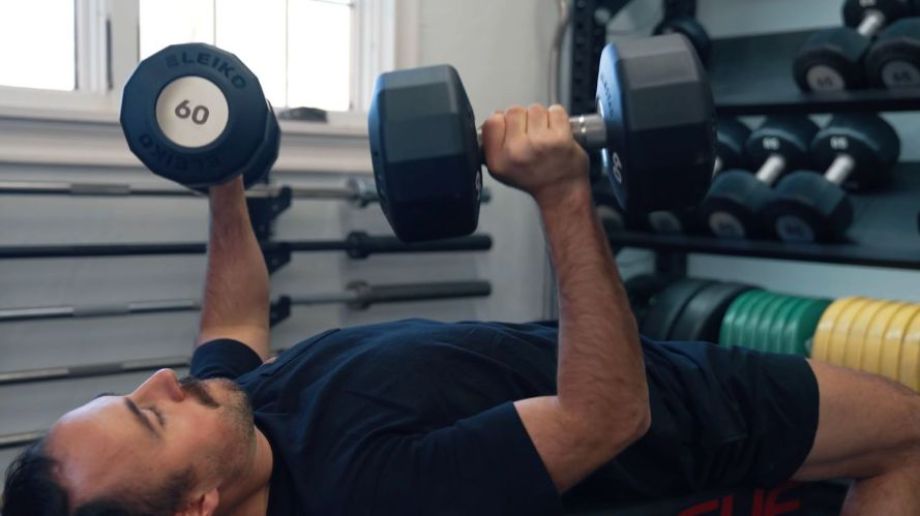
Consistency in Your Routine
It’s worth nothing that a consistent exercise routine (with appropriate scaling and progression) can also reduce muscle soreness. Intense soreness and tenderness is often a result of training in a new way, through a new range of motion, or with increased intensity.
Nutrition and Supplements
Although consuming protein is known to aid muscle growth, there is less evidence supporting protein as a method of reducing6 muscle soreness. The same goes for hydration7, but both are common recommendations from coaches and personal trainers after workouts. That said, as a certified personal trainer, I would still recommend drinking plenty of fluids and eating protein to help your overall recovery.
When it comes to supplements that support muscle recovery (and potentially reduce soreness) branched-chain amino acids (BCAAs) are typically at the top of the list for bodybuilders and athletes alike. But why? It’s because amino acids, which are the building blocks of protein, allow your body to repair the damage from the microscopic tears you get from resistance training. Essentially, BCAAs are known for assisting in the process of building protein in your muscles and reducing overall muscle breakdown.
In a 2018 study8, a group of males were split into two groups: One that drank BCAAs before exercise and the other a placebo drink. Both groups reported muscle soreness after a routine that included jump squats and vertical jumps, but the group given the BCAAs reported a significant decrease in soreness 48 to 72 hours after the workout.
Additionally, when you need a short-term solution for reducing soreness, occasional use of a non-steroidal anti-inflammatory (NSAID) drug like ibuprofen can help reduce inflammation9, but should not be used as an ongoing way to treat soreness.
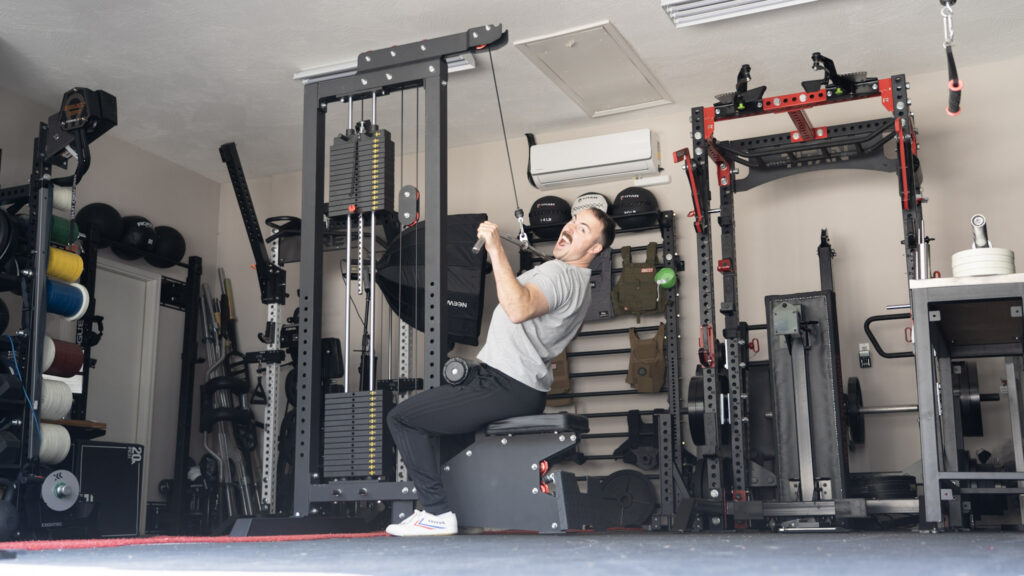
How to Prevent Soreness
Although soreness is a common side effect of lifting weights, to prevent future soreness, using an appropriate load for your fitness level will be important and making reasonable progressions to your training (and not doing too much, too soon) will help you reduce overall soreness.
Speaking as a CPT, I will be 100% honest and say that when a client complains of extreme soreness, it’s a clue for me to dial back on their workout intensity. My goal is to make sure clients are able to recover and get back into the gym for their next session, not request additional days of rest.
In addition to being mindful of your personal capability and slowly progressing, here are a few other ways to prevent future soreness:
- Focus on proper form, not overall weight
- Foam roll or self massage directly after your workout
- Stay hydrated
- Prioritize sleep and overall rest
Final Thoughts on Working Out When Sore
The decision to workout while sore (or not) is up to you. However, now that you’re armed with information about DOMS and active recovery methods, hopefully you have a better idea about how to reduce overall muscle soreness. Here are a few takeaways about working out when sore:
- Foam rollers and massage guns are two effective self-massage tools, which is one of the most effective ways to reduce soreness.
- Muscle soreness is often delayed a day or two from your workout while injuries are often sudden and acute.
- Consider taking a rest day when you have a hard time going through daily movements and your muscles are swollen and tender to the touch.
Working Out When Sore: Q&A
If I’m still sore after two days, should I workout?
It’s not unusual to experience delayed onset muscle soreness (DOMS) for up to five days after a bout of exercise. If active recovery methods like foam rolling or low-intensity movement (like walking, rowing, swimming, etc.) help alleviate soreness and stiffness, you can likely proceed to your next workout. It’s also possible to perform a lower-body routine if your upper body is still sore from a previous workout, or vice versa.
Should I workout everyday with sore muscles?
Although working out while still sore from a previous workout is okay to some degree, it’s worth mentioning that perpetual soreness or an unusual amount of soreness could be a sign of overtraining. If you’re concerned that you could be overtraining, be sure to read our in-depth guide that provides the top 10 signs you might be overtrained.
RELATED: Best Bath Soak for Sore Muscles
Are sore muscles a good sign?
Although sore muscles are often a sign that you’ve worked hard, soreness is not the only indicator of a job well done. As you progress your lifting routine, it’s likely that you’ll revisit a lot of the same exercises for contentious practice.
The more you perform the same type of movement (like squats, box squats, goblet squats, and pause squats) the less likely your body will respond with the same amount of soreness you had the first time you performed that type exercise. That said, using a fitness log can be a helpful tool for tracking progress with repetitions, load, and overall training volume so you don’t have to use soreness as a progression metric.
References
- Schoenfeld BJ. Does exercise-induced muscle damage play a role in skeletal muscle hypertrophy?. J Strength Cond Res. 2012;26(5):1441-1453. doi:10.1519/JSC.0b013e31824f207e
- Proske U. Muscle tenderness from exercise: mechanisms?. J Physiol. 2005;564(Pt 1):1. doi:10.1113/jphysiol.2005.085514
- Dupuy O, Douzi W, Theurot D, Bosquet L, Dugué B. An Evidence-Based Approach for Choosing Post-exercise Recovery Techniques to Reduce Markers of Muscle Damage, Soreness, Fatigue, and Inflammation: A Systematic Review With Meta-Analysis. Front Physiol. 2018;9:403. Published 2018 Apr 26. doi:10.3389/fphys.2018.00403
- Pearcey GE, Bradbury-Squires DJ, Kawamoto JE, Drinkwater EJ, Behm DG, Button DC. Foam rolling for delayed-onset muscle soreness and recovery of dynamic performance measures. J Athl Train. 2015;50(1):5-13. doi:10.4085/1062-6050-50.1.01
- Cheung K, Hume P, Maxwell L. Delayed onset muscle soreness : treatment strategies and performance factors. Sports Med. 2003;33(2):145-164. doi:10.2165/00007256-200333020-00005
- Pasiakos SM, Lieberman HR, McLellan TM. Effects of protein supplements on muscle damage, soreness and recovery of muscle function and physical performance: a systematic review. Sports Med. 2014;44(5):655-670. doi:10.1007/s40279-013-0137-7
- Cleary MA, Sitler MR, Kendrick ZV. Dehydration and symptoms of delayed-onset muscle soreness in normothermic men. J Athl Train. 2006;41(1):36-45.
- VanDusseldorp TA, Escobar KA, Johnson KE, et al. Effect of Branched-Chain Amino Acid Supplementation on Recovery Following Acute Eccentric Exercise. Nutrients. 2018;10(10):1389. Published 2018 Oct 1. doi:10.3390/nu10101389
- Howatson G, van Someren KA. The prevention and treatment of exercise-induced muscle damage. Sports Med. 2008;38(6):483-503. doi:10.2165/00007256-200838060-00004
Further reading

Adding glute exercises to your workout routine can reduce pain and improve athletic performance. Here’s how to do the seven best gluteus maximus exercises. Read more

When you want fresh air while you work out but you don’t want to let the bugs in, our top picks for best garage door screen has you covered. Read more

When it comes to bumper plates, you pretty much have one material choice and that is rubber. Read more

What happens when your muscles are so tender that squatting down to the toilet is a chore? Can you workout when sore or is the pain a cue to take a rest day? Here’s the thing: If you continuously stimulate your muscles from strength training (like bodybuilding splits or the big three lifts), it’s pretty common for your workout routine to deliver some amount of soreness. Muscle soreness is definitely part of the muscle-building process, » Read more about: The Age-Old Debate of Working Out When Sore: When is it Too Much? » Read more

